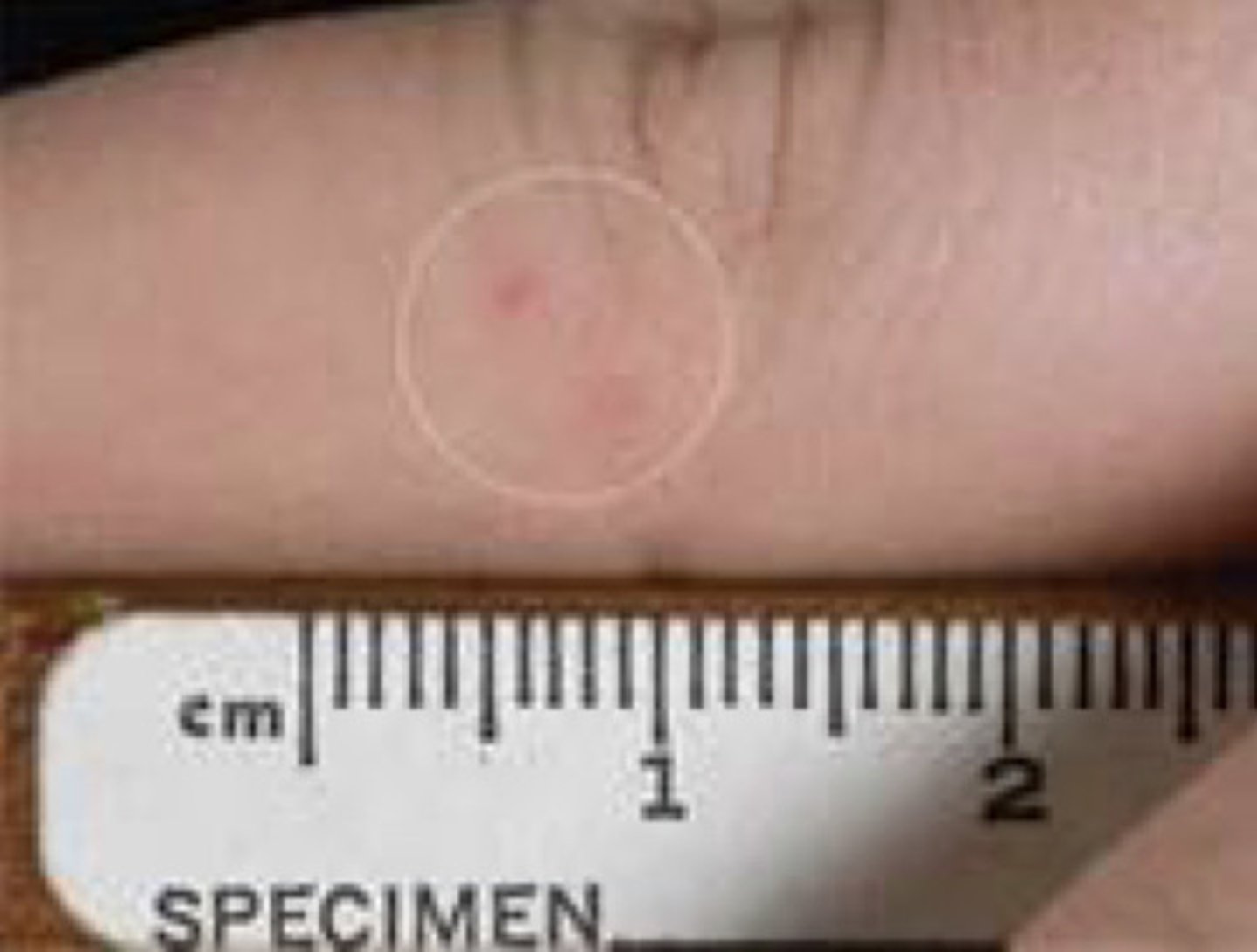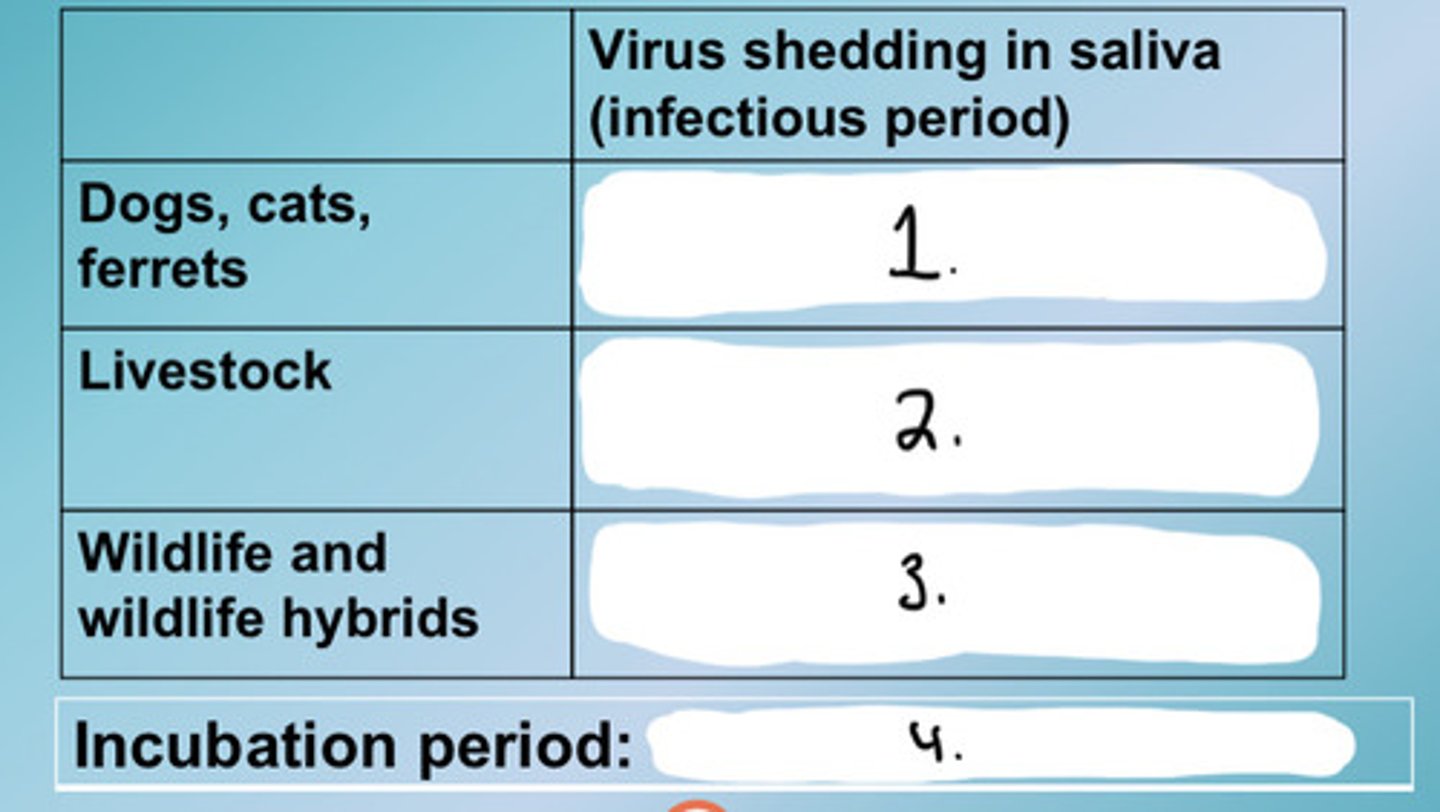3. Rabies Review
1/40
There's no tags or description
Looks like no tags are added yet.
Name | Mastery | Learn | Test | Matching | Spaced |
|---|
No study sessions yet.
41 Terms
True — it has the highest mortality of any disease worldwide.
T/F: Rabies is nearly 100% fatal.
- Raccoons
- Bats
What two animal types are the main rabies reservoirs in Florida?
- Cats = most likely to be found rabid
- Dogs
- Ferrets
Which three animal species are required to be vaccinated against rabies in Florida? Which of these is the domestic species most frequently found to be rabid in Florida?
4 months of age
By what age are cats, dogs, and ferrets required to be vaccinated against rabies in Florida?
He is not considered protected until 4 weeks after vaccination —>
- 4 month quarantine
- Euthanasia
A pet dog receives his first rabies vaccine when he is two years of age. Two weeks later, he is in a fight with a raccoon, who is killed in the encounter. The raccoon tests positive for rabies at the state public health laboratory. How should the dog be managed?
One month (28 days)
How long does it take for domestic animals to mount a protective immune response from the first documented vaccination?
- Cats = 2 or 3 months
- Dogs = 3 months
- Ferrets = 3 months
What is the earliest that cats, dogs, and ferrets can be vaccinated for rabies?
Lower right rear leg
Where on the body are rabies vaccines given?
Bats
Which animal type can transmit rabies through a very minor wound that may be difficult to see?

False — they can still have clinical rabies.
T/F: Wildlife and other animals who are less than four months of age are too young to have clinical rabies.
True.
T/F: Veterinarians are required by state law to report potential exposures.
- Virus enters at bite site
- Virus goes up the nerves into the spinal cord and brain (that infection can now be detected by testing)
- Virus rapidly travels to the salivary glands (the animal is now infectious)
- Virus is shed in saliva and the animal is ill
(NOTE — time from bite to illness takes from 10 days to 4-6 months).
Describe the pathophysiology of rabies infection.
- Saliva
- Brain
- Tissues with nerves
- CSF
- Tears
Out of the following list, pick out what is infectious:
- Saliva
- Blood
- Brain
- Tissues with nerves
- Urine
- CSF
- Tears
- Feces
- Blood
- Urine
- Feces
Out of the following list, pick out what is not infectious:
- Saliva
- Blood
- Brain
- Tissues with nerves
- Urine
- CSF
- Tears
- Feces
Bite
What is the most common mode of transmission for rabies?

False — it does not persist well in the environment. It is an enveloped virus and quite fragile.
T/F: Rabies survives well in the environment.
Direct fluorescent antibody test (DFAT) of fresh, refrigerated, or frozen samples (NOT fixed samples).
(NOTE — PCR testing to be available in the future).
Describe the current rabies testing methodology.
- Isolation = separates sick people with a contagious disease from people who are not sick (based on the shedding period).
- Quarantine = separates and restricts the movement of people who are exposed to a contagious disease to see if they become sick (based on the incubation period).
Describe the difference between isolation and quarantine.
10 days
What is the typical isolation period?
- Revaccinate immediately
- 45-day owner observation
How do you manage the following animal who was bitten?:
- Dog, cat, ferret, or livestock who is currently vaccinated against rabies.
- Revaccinate immediately (ideally within 96 hours)
- Generally a 45-day owner observation unless delay in booster vaccination, severe attack, or other relevant factors
How do you manage the following animal who was bitten?:
- Dog or cat overdue for rabies vaccination with proof of previous rabies vaccination.
- Manage as unvaccinated
OR
- Titer before and after rabies vaccination with a specific timeline for sample collection (at the owner's expense)
How do you manage the following animal who was bitten?:
- Dog or cat overdue for rabies vaccination with no proof of previous vaccination.
- Euthanize
OR
- Vaccinate and 4 month quarantine
How do you manage the following animal who was bitten?:
- Dog or cat not vaccinated against rabies.
- Euthanize
OR
- Vaccinate and 6 month quarantine
How do you manage the following animal who was bitten?:
- Unvaccinated ferret or livestock.
- Euthanize
How do you manage the following animal who was bitten?:
- Other animals.
Members of the Florida Rabies Advisory Committee:
- Florida Department of Health
- FDACS
- Florida Animal Control Association
- FWC
- Florida Medical Association
- FVMA
- Florida Department of Environmental Protection
- Humane Society of U.S.
- University of Florida
A rabies alert is issued following the identification of a rabid unowned kitten in an area where a significant number of unowned animals have been observed. What partners should be routinely notified of the alert by local or state DOH personnel?
Dog is considered unvaccinated:
- Euthanize OR vaccines and 4 month quarantine
A 3-year-old dog is in an encounter with a raccoon who is not captured for testing. The owner reports that they have been vaccinating the dog every year from vaccines purchased at a feed store. How should that dog be managed?
Cat is considered exposed and unvaccinated:
- Euthanize OR vaccinate and 4 month quarantine
An unowned cat with a clipped ear is captured by a Good Samaritan after she is observed to have wounds that are suspected to be due to a fight with or an attack by an unknown animal. How should this cat be managed?
FDACS due to crossing state lines
A puppy is placed in a 4 month quarantine following an exposure with a raccoon. The owner was in the process of moving to another state at the time of the encounter and will be starting work in that state in the next 2 weeks. They want to know if the quarantined dog can be transferred to another state. Which agency/agencies have jurisdiction over this request?
FDACS (Florida Department of Agriculture and Consumer Services)
A neurologic goat with a history of a recent wound of unknown origin tests positive for rabies. Which agency/agencies would oversee the quarantine for other goats in the same pen?
14 days
An unvaccinated mule bites a person trying to pet it. How long should the mule be observed for?
No. It is not legally required for mules to be vaccinated against rabies in Florida.
An unvaccinated mule bites a person trying to pet it. Is the owner out of compliance with the state law if the mule is not currently vaccinated?
1. <10 days before onset of symptoms and through illness
2. <14 days
3. Unknown
4. Generally <4-6 months

- Date previously vaccinated (current vaccination)
Which of the following is not a required data field on a rabies vaccination certificate?
- Species
- Sex
- Age
- Predominant colors/markings
- Date previously vaccinated (current vaccination)
- Vaccine serial (lot) number
- Veterinarian's signature and license number
Florida Fish and Wildlife Conservation Commission (FWC)
A pet monkey bites someone. What agency holds permits for exotic pets and most captive wildlife?
Macaques?
What group/genus of nonhuman primates is at high risk for herpes B virus infection? (NOTE — this virus has zoonotic potential)
Treat as a high risk species (i.e. like a raccoon)
- Test the kinkajou
OR
- Recommend post-exposure prophylaxis
A vaccinated pet kinkajou bites a friend of the owner. How should that kinkajou be managed?
Testing is generally recommended if it can be done promptly. Otherwise, rabies PEP may be initiated due to the shorter incubation times that can be seen with moderate-to-severe head and neck bites.
An unvaccinated dog chained outside bites a child in the face when the child approaches the dog while he is eating. This child is hospitalized. How is that dog managed?
The head and neck
A bite where on the body may have a shorter incubation period?
The County Health Department likely would recommend testing in this situation, unless they were certain no unreported bites/scratches occurred.
A neurologic stray kitten is found an an elementary school playground, but no one has reported a bite or scratch. Should the kitten be tested for rabies?
- Between 21 days up to 3 years after the second vaccination only for those at ongoing risk of infection
- When your titer drops below 0.5 IU/mL
You just completed the rabies pre-exposure prophylaxis vaccination series. When should you next receive a rabies booster vaccination?